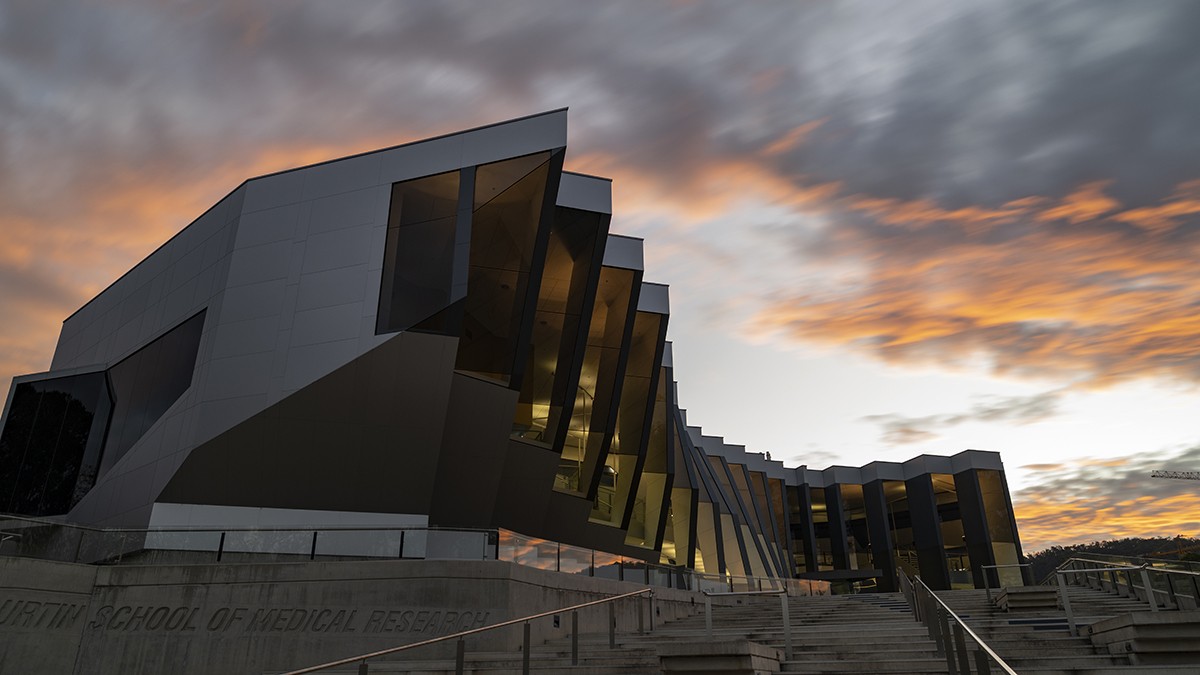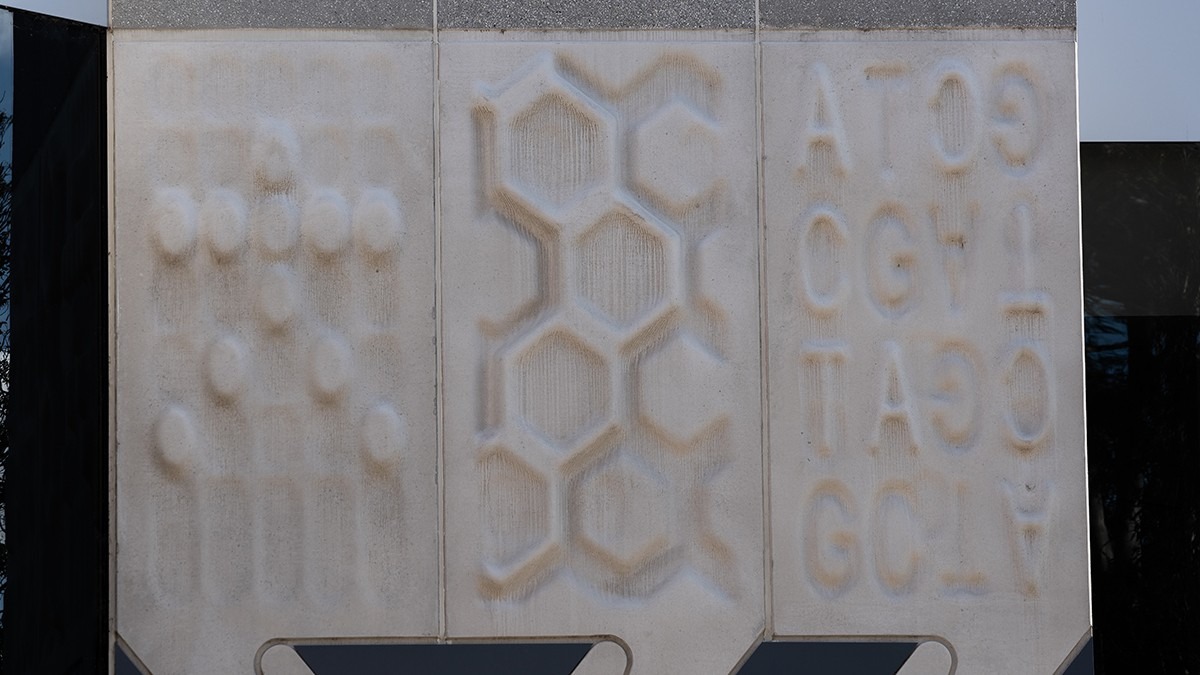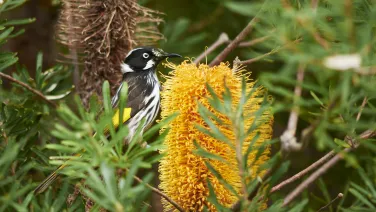
Have you ever noticed these seven hidden architectural gems on campus?
Having been a science student at ANU for three years, I’ve come to appreciate our great labs and science teaching facilities. But have you ever stopped to look at the buildings themselves?
Whether you’re a new student at ANU or one who has been here for years, a lot of the intricate building designs go unnoticed. Our science and medicine facilities have fascinating histories, hidden sculptures and clever designs that mirror the science happening inside.
So come on a virtual journey with me around our science precinct to find seven hidden gems. How many have you noticed?
Art meets science at CPAS
The Australian National Centre for the Public Awarness of Science (CPAS) is the home of science communication at ANU. But did you know its building once housed the ANU Medical School?
Anne Ferguson’s medicine-themed ‘Life’s Shadows’ is a glass mural on top of the main University Avenue entrance to the Peter Baume building.
It shows a microscopic view of the human cell, including the endoplasmic reticulum part of our cells which helps make, fold and transport proteins. The small horizontal lines show a DNA ‘fingerprint’, which can be used to identify people using unique patterns in their DNA.
But to me, one of the strangest things in CPAS isn’t Dr Graham Walker’s leaf-blower hoverboard. I’ve always been oddly fascinated by the unusually deep sinks in the bathrooms.
It turns out these sinks are so huge because doctors in the old medical school would use them to wash their hands thoroughly before and after practicing surgeries and dissecting bodies!
Too good to destroy: The Untitled Research School of Chemistry sculpture with a long history
This eight-metre towering concrete sculpture was rescued from the old ANU Research School of Chemistry building when it was demolished long ago, and it now exists on University Avenue.
I was curious to figure what it was actually called, and with some help from the ANU Drill Hall Gallery archival staff I discovered it doesn’t actually have a name.
After mistakenly being called ‘Tree of Man’ for many years, the late artist Lenton Parr actually wrote ANU a letter to say that “Tree of Man is downright misleading”.
“In fact, the design of the sculpture derived from the idea of crystal formation – crystallography and X-ray diffraction were areas of interest in the school (of Chemistry) at that time,” he went on to write.
These techniques were new in the 1960s when the sculpture was made but are still used today to identify the structure of proteins!
Ever noticed that exclamation mark on the wall near the Research School of Physics?
I remember hearing the exciting news in 2015 that Einstein’s prediction of gravitational waves had finally been proved, and it turns out ANU has its own research facility dedicated to helping with the search for gravitational waves!
The Gravitational Wave building where astrophysicists detect these waves from space is covered in a metallic mural that looks like an exclamation mark. This symbol actually depicts the cool work on gravitational waves happening inside!
‘Pulse’ by Marion Borgelt shows one metal droplet falling through space into a grid-like rippling pathway of many droplets, resembling how the waves have ordered movement, time, and sequence as mass accelerates.
There’s more to all that concrete at JCSMR
The first time I stepped inside the John Curtin School of Medical Research (JCSMR), I was in awe at how modern and fancy it looked. But I’m sure many students will agree with me when I say those wide steps are really awkward to climb!
It turns out the steps are like this because the entire building is shaped like a DNA double helix. This also explains why the windows are angled and staggered from ceiling to floor.
The side of JCSMR also has four engraved, white-concrete panels depicting a famous advancement in the history of biology:
One panel shows the DNA double helix, the structure of genetic information in our cells, while another shows the bases which make up the letters of our DNA code: Adenine, Thymine, Cytosine and Guanine.
The clusters of hexagons refer to the first diagrams of cell structure that Robert Hooke drew when he looked down the microscope and saw cork cells in 1665.
And that strange star shape which nobody could figure out? It’s actually a pictogram of the famous Vitruvian Man, Leonardo da Vinci’s drawing on the mathematical proportions of the human body.
A window into our galaxy
This 2013 stainless-steel sculpture known as ‘Una’ (ANU spelled backwards), made by Wolfgang Buttress and astrophysicist Dr. Daniel Bayliss, is known among students as ‘The Silver Ball’.
In fact, it was one of the first things I showed my family the first time they visited Canberra to see where I study. I can also confirm the grass next to Una is a great place for a picnic.
Have you ever looked inside when the lighting is just right? The many tiny holes in the side of this metal ball are carefully mapped out to accurately represent the 9,100 stars visible to the naked eye in the night sky!
Is that someone’s spine in the ANU Hancock Library courtyard?
Just outside the Hancock library main stairwell window is Hezzie Carleton’s 1999 sculpture ‘Ingress egress’. And I must admit, I have been accidentally spooked by this spine-tingling sculpture on many a late-night study slam.
This triangle of three glass spinal backbones allows water to peacefully trickle down each of the vertebrae and discs, which the artist believes shows the relationship between structure, function and beauty in both art and nature.
The weird windows at the Research School of Biology
The Research School of Biology’s Linnaeus Building is home to the Australian Research Council’s Centre of Excellence in Plant Energy Biology. The lab facilities inside are a wonderful team environment, aided by the building’s very large, polygonal windows to let in the warm sunshine.
Each window actually resembles a ‘carboxysome’, which are found in the bacteria that increased the oxygen levels on early Earth using proteins that take up carbon from the atmosphere, just like plants do.
These marvels truly are places of learning, both inside and out. If you're on campus, keep your eyes peeled for any more hidden gems you can find. And if you're learning remotely, I hope this has transported you back to campus, if just for a moment!
See for yourself: take a virtual tour around the ANU Science Precint.













